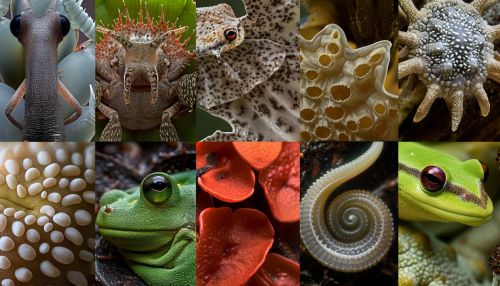Ecological Adaptations
Introduction
Ecological adaptations refer to the alterations and adjustments organisms undergo to increase their fitness within their ecological niches. These adaptations can be morphological, physiological, or behavioral, and they are driven by the process of natural selection. The concept of ecological adaptations is central to the field of evolutionary biology, as it provides an explanation for the diversity and complexity of life on Earth.
Morphological Adaptations


Morphological adaptations are physical changes that occur in organisms over generations, enhancing their ability to survive and reproduce in their environments. These adaptations can be as simple as changes in body size or shape, or as complex as the development of specialized structures like the beak of a Darwin's finch or the camouflage of a stick insect.
Camouflage
One of the most common morphological adaptations is camouflage, which allows organisms to blend in with their surroundings. This adaptation can help predators avoid detection by their prey, or help prey avoid being seen by predators. For example, the snowshoe hare changes its fur color from brown in the summer to white in the winter to blend in with the snow, helping it avoid predators.
Mimicry
Another common morphological adaptation is mimicry, where one species evolves to resemble another, often more dangerous or unpalatable species. This can deter predators or competitors, giving the mimicking species a survival advantage. For example, the harmless milk snake mimics the coloration of the venomous coral snake to deter potential predators.
Physiological Adaptations
Physiological adaptations are changes in an organism's metabolic processes, which can enhance survival and reproduction. These adaptations can include changes in digestion, respiration, or reproduction, among others.
Thermoregulation
One key physiological adaptation is thermoregulation, the ability of an organism to maintain its body temperature within certain boundaries, even when the surrounding temperature is very different. For example, penguins have a layer of blubber that insulates their bodies, allowing them to survive in the frigid Antarctic waters.
Metabolic Rate
Another important physiological adaptation is the adjustment of an organism's metabolic rate. Some organisms can slow their metabolism during periods of food scarcity to conserve energy, a process known as hibernation or torpor. For example, the Arctic ground squirrel can lower its body temperature to just above freezing during hibernation, drastically reducing its metabolic rate and energy needs.
Behavioral Adaptations
Behavioral adaptations are changes in an organism's behavior that increase its chances of survival and reproduction. These adaptations can include changes in feeding habits, mating rituals, or social behaviors.
Foraging Strategies
One common behavioral adaptation is the development of specialized foraging strategies. For example, the honey bee performs a "waggle dance" to communicate the location of food sources to other members of the hive.
Mating Rituals
Another common behavioral adaptation is the evolution of complex mating rituals. For example, male peafowl display their colorful tail feathers and perform a complex dance to attract females.
Conclusion
Ecological adaptations are a fundamental aspect of life on Earth, driving the diversity and complexity of organisms. Through the process of natural selection, organisms continually adapt to their environments, leading to the vast array of life forms we see today.
